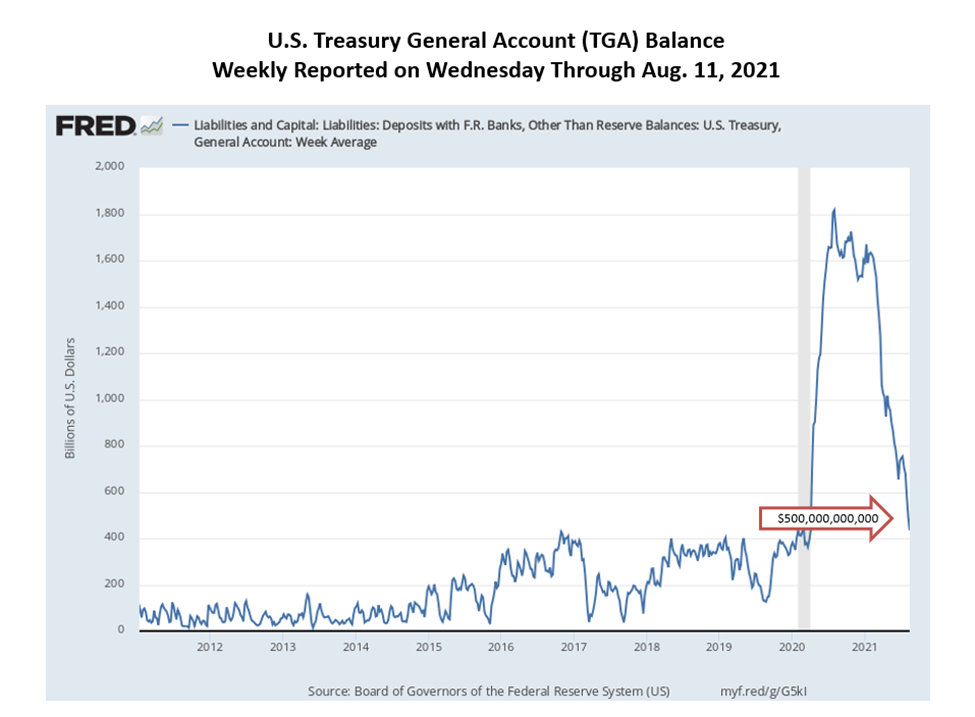Debt Ceiling Season’s Impact on Stocks and U.S. Credit Ratings
The debt ceiling wrestling match and the U.S. Treasury’s inability to meet the responsibilities of the U.S. Government are likely to cause higher market volatility in the coming months. The suspension of debt limits has just expired, this kicks off the 2021 season, and a note from Janet Yellen is about to make a lot of people concerned.
The debt ceiling (statutory debt limit) is the maximum amount of debt the United States can have outstanding in Treasury debt. The limit had been suspended in March of 2020 to keep the economy afloat by raising money through debt for businesses and individuals. The suspension was not indefinite and has recently expired.

The balance in the Treasury General Account (TGA), which is effectively the checking account for bill paying by the US government, has plunged from $1 trillion at the end of April, to $435 billion this week (August 12). This steep plunge in altitude was required to comply with the end of the statutes’ hiatus. In January, the Secretary of the Treasury Yellen said it would draw down the TGA from its then level of $1.6 trillion to $500 billion by this summer. On August 1, the existing debt ceiling became effective. According to the letter Yellen wrote to the House Speaker and Senate leaders there are immediate expenses that won’t be able to get paid.
In this letter to Congress concerning the US meeting entitlement obligations, Yellen spelled out to Congress some “extraordinary measures,” the Treasury will take to keep the US from defaulting. The three large government-funded retirement systems topped her list:
-The Civil Service Retirement and Disability Fund
-The Postal Service Retiree Health Benefits Fund.
-The Government Securities Investment Fund (G Fund) of the Thrift Savings Fund that are part of the Federal Employees’ Retirement System.
All entitlements above are required by law to be (eventually) funded and are expected to be made whole as money becomes available by Congress hiking the amount of debt the Treasury can borrow by issuing US Treasury obligations.
If the debt ceiling is not raised by Congress, (or taxes hiked and budgets slashed), this list will grow. At some point, if money isn’t made available there will be concern that the US Treasury won’t be able to meet its debt payments. This will draw a reaction by rating agencies and investors. For example, in August of 2011, the rating agency S&P cut the U.S. credit rating to AA+ and maintained a negative outlook. With the ratings change S&P analysts cited concerns of growing budget deficits. Rating downgrades typically cause investors (lenders) to seek higher interest rates for their new perceived risk.
Rating Agencies
Fitch, a Nationally Recognized Statistical Rating Organization (NRSRO), placed the US’s credit rating on negative outlook in July of 2020. Last month while reaffirming its AAA rating Fitch expressed heightened concern of financial activity they say will push the country further from a stabilized debt burden. The NRSRO said the US could be downgraded without a plan to balance debt and spending “in the post-pandemic phase.”
In June, Moody’s expressed its views about the US debt burden. “While the coronavirus pandemic has created unprecedented challenges for the US economy and exacerbated the pace of deterioration of the government’s fiscal position, Moody’s expects the US economy to recover over time and the sovereign’s credit profile to remain resilient to the shock,”
S&P, the third NRSRO covering US debt has a stable outlook on its AA+ rating. This maintained level is based on the dollar’s reserve status and institutional strengths, as well as the credibility of the Federal Reserve.
Looking Toward History for Guidance on Debt
The current year may not follow the pattern of other years as there have been many new and inventive financial strategies the US has taken to achieve goals over the past 18 months. However, this is what has generally happened each year over the decades (the statutory debt ceiling was enacted in 1917).
Since 1960, each time the debt ceiling needed to be raised by Congress to pay bills required by Congress, those involved in working out the solution let the activity go down to the wire thereby creating an emergency situation. Defaulting on Treasury debt would topple world bond and equity markets while likely strengthening some commodities like gold and silver. Each time this has happened concessions were made, the debt ceiling was either raised or extended (or suspended), and we moved on until the following year when debt ceiling season.
Take-Away
Debt ceiling season this year has all the ingredients it needs to be even more tumultuous. The government debt is viewed as excessive relative to GDP. Washington’s spending “guarantees” have grown dramatically, there are still some concerned about how ready workers are to return to work, and money is flowing from the Treasury’s checkbook at a pace of $100 billion per week.
During past years the talk of if there “will be a deal,” “will they vote on a deal,” “they have a deal but Congress is on vacation,” sends the stock market into a volatility-tizzy. There’s no reason to expect this year’s to not be disruptive.
Stay in touch with our updates on the economy, exciting industries, and company research by registering at no cost at Channelchek.
Managing Editor, Channelchek
Suggested Reading:
 What Metals Can Tell Us About the Economy
|
 The Correlation Between Stocks and Unemployment
|
 Metals & Mining – Second Quarter 2021 Review and Outlook
|
 Energy Industry – 2021 2Q Review and Outlook
|
Sources:
https://home.treasury.gov/system/files/136/Debt-Limit-Letter-Congress_20210802_Pelosi.pdf
https://home.treasury.gov/news/press-releases/jy0304
https://www.federalreserve.gov/releases/h41/
https://www.bbc.com/news/world-us-canada-14428930
Stay up to date. Follow us:

|
